Comprehensive Report on Accounting Fundamentals and Cost Accounting
VerifiedAdded on 2021/01/01
|10
|3097
|196
Report
AI Summary
This report provides a comprehensive overview of accounting fundamentals, emphasizing cost accounting and financial statement analysis. It begins by defining accounting's role in business communication and explores key concepts such as separate entity, money measurement, going concern, and dual aspect. The report then delves into the accounting information system, double-entry bookkeeping, and the preparation of essential financial statements like the balance sheet and profit and loss account. It addresses accounting adjustments including VAT, stocks, depreciation, and accruals. The core of the report focuses on the nature and purpose of cost accounting, cost centres, and cost units, differentiating between cost and financial accounting. It examines cost classification, behaviour, and purpose, including fixed and variable costs, and direct and indirect costs. Furthermore, the report discusses the elements of production and non-production costs, cost accounting techniques such as job costing, process costing, and standard costing, and accounting for materials using methods like LIFO and FIFO.
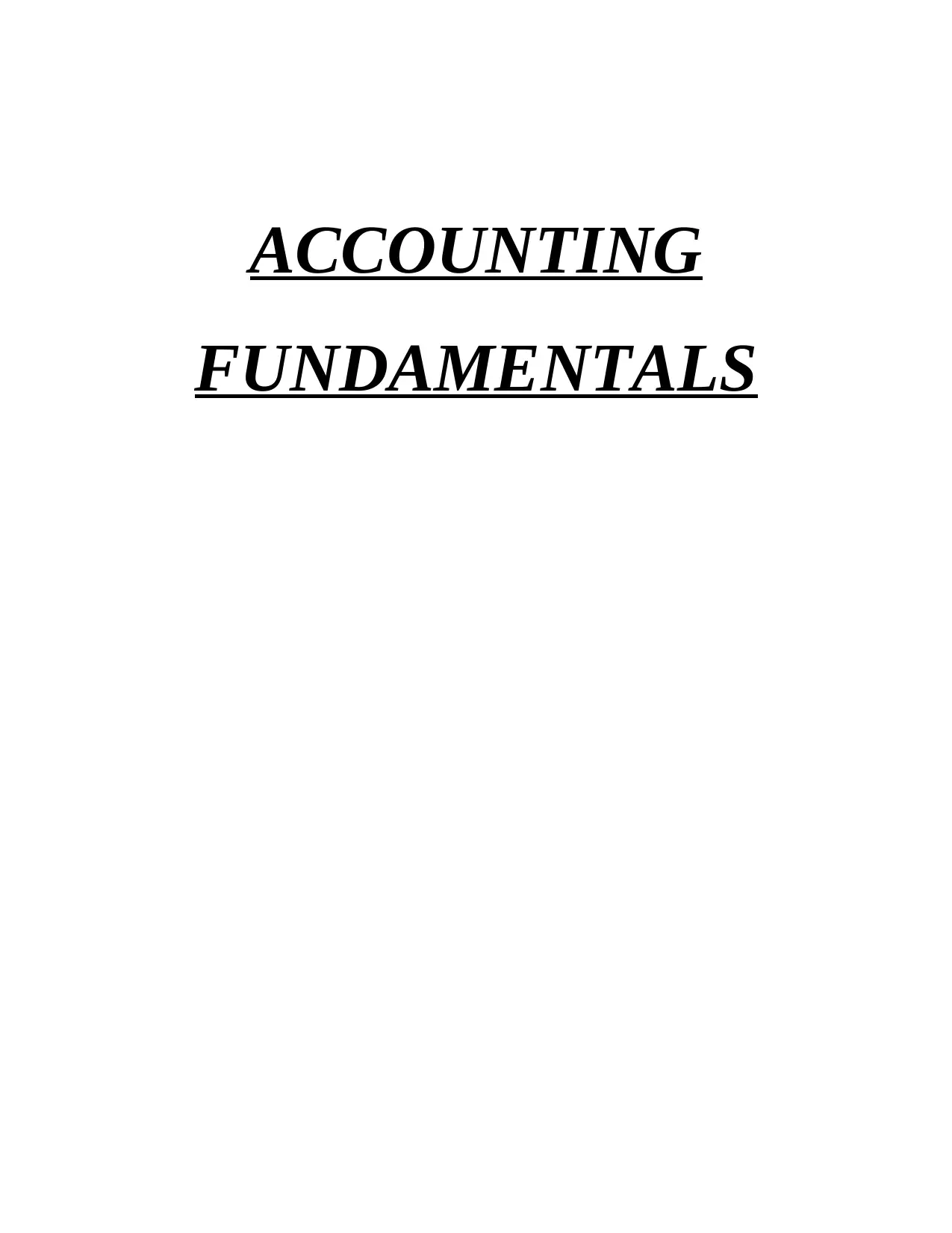
ACCOUNTING
FUNDAMENTALS
FUNDAMENTALS
Paraphrase This Document
Need a fresh take? Get an instant paraphrase of this document with our AI Paraphraser

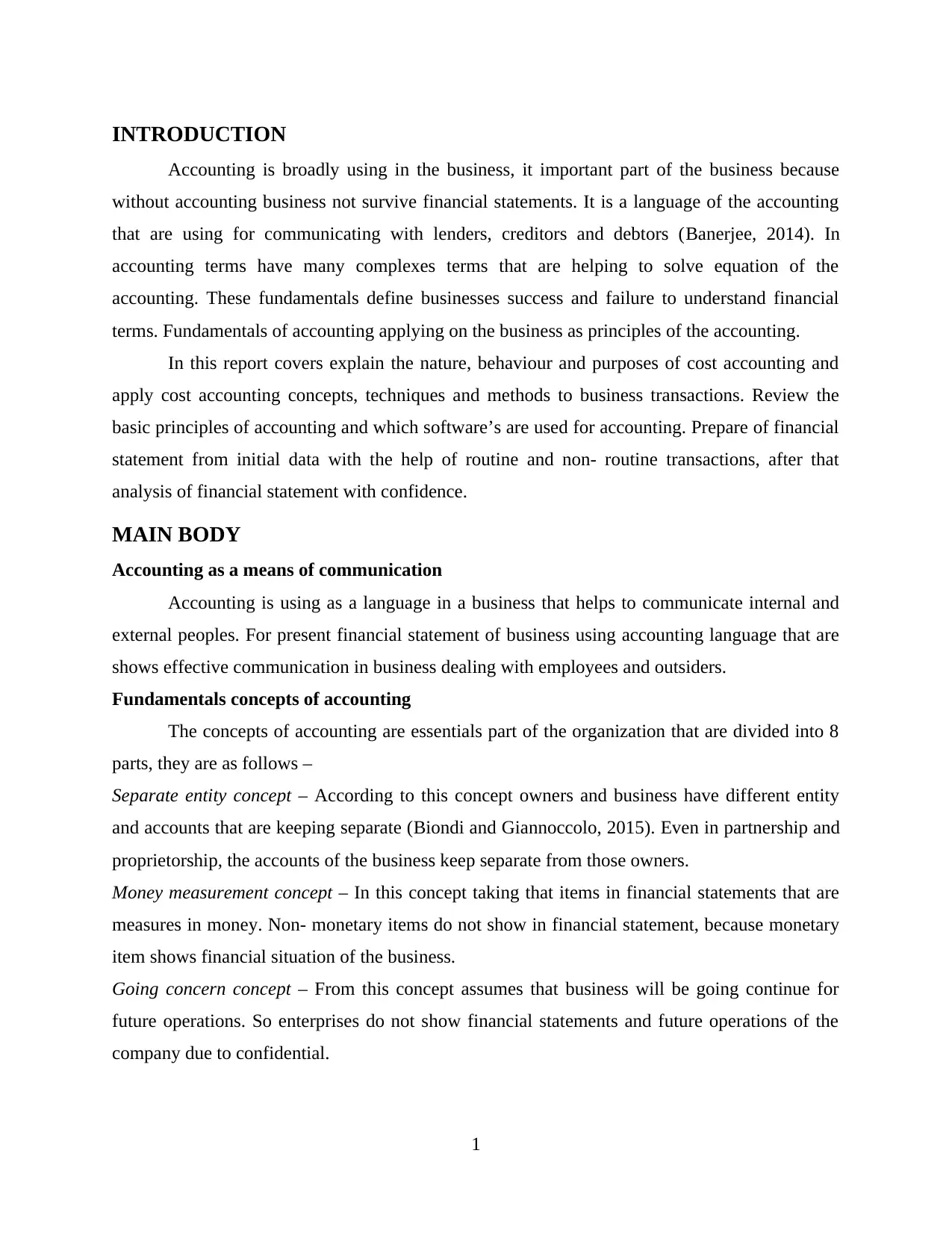
INTRODUCTION
Accounting is broadly using in the business, it important part of the business because
without accounting business not survive financial statements. It is a language of the accounting
that are using for communicating with lenders, creditors and debtors (Banerjee, 2014). In
accounting terms have many complexes terms that are helping to solve equation of the
accounting. These fundamentals define businesses success and failure to understand financial
terms. Fundamentals of accounting applying on the business as principles of the accounting.
In this report covers explain the nature, behaviour and purposes of cost accounting and
apply cost accounting concepts, techniques and methods to business transactions. Review the
basic principles of accounting and which software’s are used for accounting. Prepare of financial
statement from initial data with the help of routine and non- routine transactions, after that
analysis of financial statement with confidence.
MAIN BODY
Accounting as a means of communication
Accounting is using as a language in a business that helps to communicate internal and
external peoples. For present financial statement of business using accounting language that are
shows effective communication in business dealing with employees and outsiders.
Fundamentals concepts of accounting
The concepts of accounting are essentials part of the organization that are divided into 8
parts, they are as follows –
Separate entity concept – According to this concept owners and business have different entity
and accounts that are keeping separate (Biondi and Giannoccolo, 2015). Even in partnership and
proprietorship, the accounts of the business keep separate from those owners.
Money measurement concept – In this concept taking that items in financial statements that are
measures in money. Non- monetary items do not show in financial statement, because monetary
item shows financial situation of the business.
Going concern concept – From this concept assumes that business will be going continue for
future operations. So enterprises do not show financial statements and future operations of the
company due to confidential.
1
Accounting is broadly using in the business, it important part of the business because
without accounting business not survive financial statements. It is a language of the accounting
that are using for communicating with lenders, creditors and debtors (Banerjee, 2014). In
accounting terms have many complexes terms that are helping to solve equation of the
accounting. These fundamentals define businesses success and failure to understand financial
terms. Fundamentals of accounting applying on the business as principles of the accounting.
In this report covers explain the nature, behaviour and purposes of cost accounting and
apply cost accounting concepts, techniques and methods to business transactions. Review the
basic principles of accounting and which software’s are used for accounting. Prepare of financial
statement from initial data with the help of routine and non- routine transactions, after that
analysis of financial statement with confidence.
MAIN BODY
Accounting as a means of communication
Accounting is using as a language in a business that helps to communicate internal and
external peoples. For present financial statement of business using accounting language that are
shows effective communication in business dealing with employees and outsiders.
Fundamentals concepts of accounting
The concepts of accounting are essentials part of the organization that are divided into 8
parts, they are as follows –
Separate entity concept – According to this concept owners and business have different entity
and accounts that are keeping separate (Biondi and Giannoccolo, 2015). Even in partnership and
proprietorship, the accounts of the business keep separate from those owners.
Money measurement concept – In this concept taking that items in financial statements that are
measures in money. Non- monetary items do not show in financial statement, because monetary
item shows financial situation of the business.
Going concern concept – From this concept assumes that business will be going continue for
future operations. So enterprises do not show financial statements and future operations of the
company due to confidential.
1
⊘ This is a preview!⊘
Do you want full access?
Subscribe today to unlock all pages.

Trusted by 1+ million students worldwide
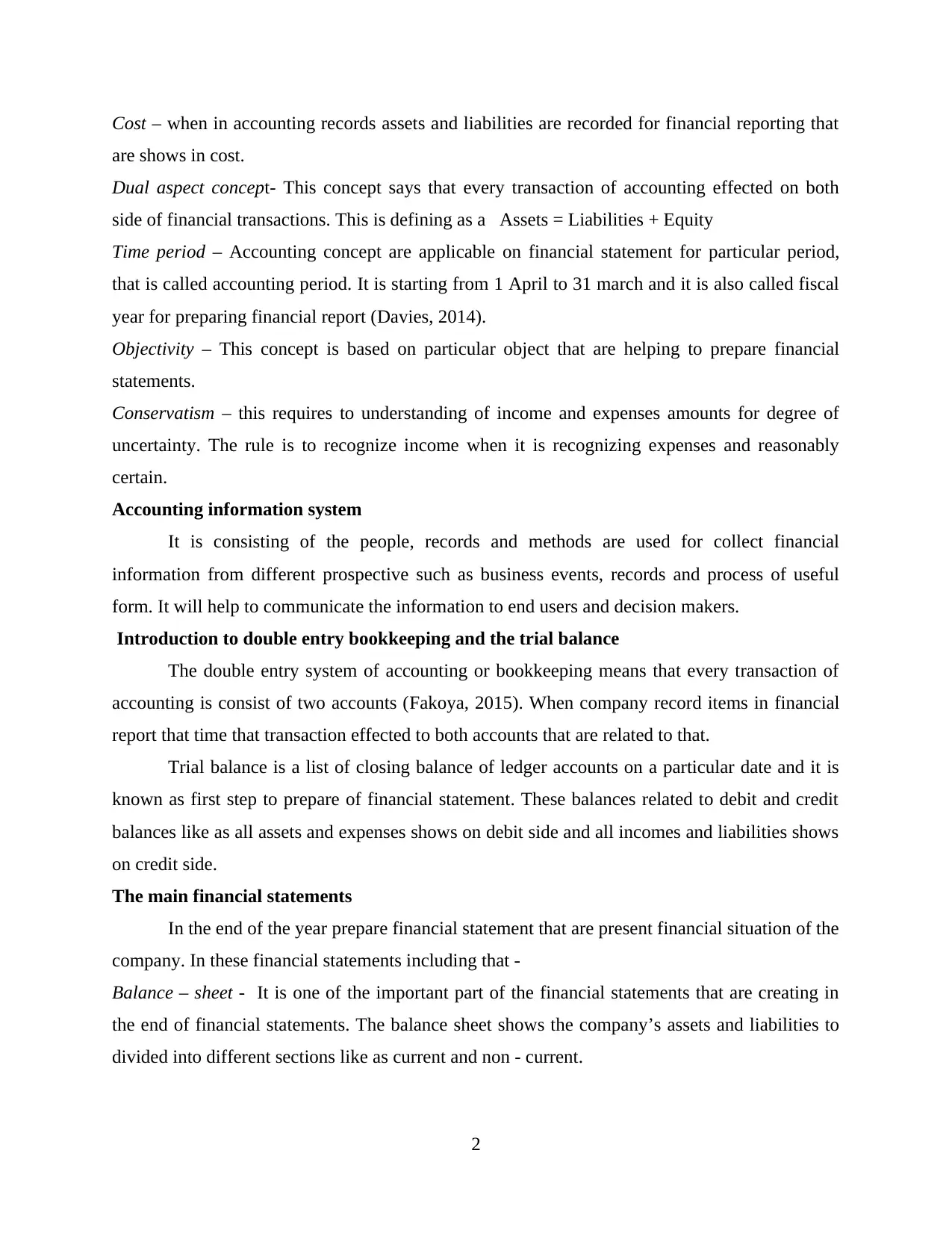
Cost – when in accounting records assets and liabilities are recorded for financial reporting that
are shows in cost.
Dual aspect concept- This concept says that every transaction of accounting effected on both
side of financial transactions. This is defining as a Assets = Liabilities + Equity
Time period – Accounting concept are applicable on financial statement for particular period,
that is called accounting period. It is starting from 1 April to 31 march and it is also called fiscal
year for preparing financial report (Davies, 2014).
Objectivity – This concept is based on particular object that are helping to prepare financial
statements.
Conservatism – this requires to understanding of income and expenses amounts for degree of
uncertainty. The rule is to recognize income when it is recognizing expenses and reasonably
certain.
Accounting information system
It is consisting of the people, records and methods are used for collect financial
information from different prospective such as business events, records and process of useful
form. It will help to communicate the information to end users and decision makers.
Introduction to double entry bookkeeping and the trial balance
The double entry system of accounting or bookkeeping means that every transaction of
accounting is consist of two accounts (Fakoya, 2015). When company record items in financial
report that time that transaction effected to both accounts that are related to that.
Trial balance is a list of closing balance of ledger accounts on a particular date and it is
known as first step to prepare of financial statement. These balances related to debit and credit
balances like as all assets and expenses shows on debit side and all incomes and liabilities shows
on credit side.
The main financial statements
In the end of the year prepare financial statement that are present financial situation of the
company. In these financial statements including that -
Balance – sheet - It is one of the important part of the financial statements that are creating in
the end of financial statements. The balance sheet shows the company’s assets and liabilities to
divided into different sections like as current and non - current.
2
are shows in cost.
Dual aspect concept- This concept says that every transaction of accounting effected on both
side of financial transactions. This is defining as a Assets = Liabilities + Equity
Time period – Accounting concept are applicable on financial statement for particular period,
that is called accounting period. It is starting from 1 April to 31 march and it is also called fiscal
year for preparing financial report (Davies, 2014).
Objectivity – This concept is based on particular object that are helping to prepare financial
statements.
Conservatism – this requires to understanding of income and expenses amounts for degree of
uncertainty. The rule is to recognize income when it is recognizing expenses and reasonably
certain.
Accounting information system
It is consisting of the people, records and methods are used for collect financial
information from different prospective such as business events, records and process of useful
form. It will help to communicate the information to end users and decision makers.
Introduction to double entry bookkeeping and the trial balance
The double entry system of accounting or bookkeeping means that every transaction of
accounting is consist of two accounts (Fakoya, 2015). When company record items in financial
report that time that transaction effected to both accounts that are related to that.
Trial balance is a list of closing balance of ledger accounts on a particular date and it is
known as first step to prepare of financial statement. These balances related to debit and credit
balances like as all assets and expenses shows on debit side and all incomes and liabilities shows
on credit side.
The main financial statements
In the end of the year prepare financial statement that are present financial situation of the
company. In these financial statements including that -
Balance – sheet - It is one of the important part of the financial statements that are creating in
the end of financial statements. The balance sheet shows the company’s assets and liabilities to
divided into different sections like as current and non - current.
2
Paraphrase This Document
Need a fresh take? Get an instant paraphrase of this document with our AI Paraphraser
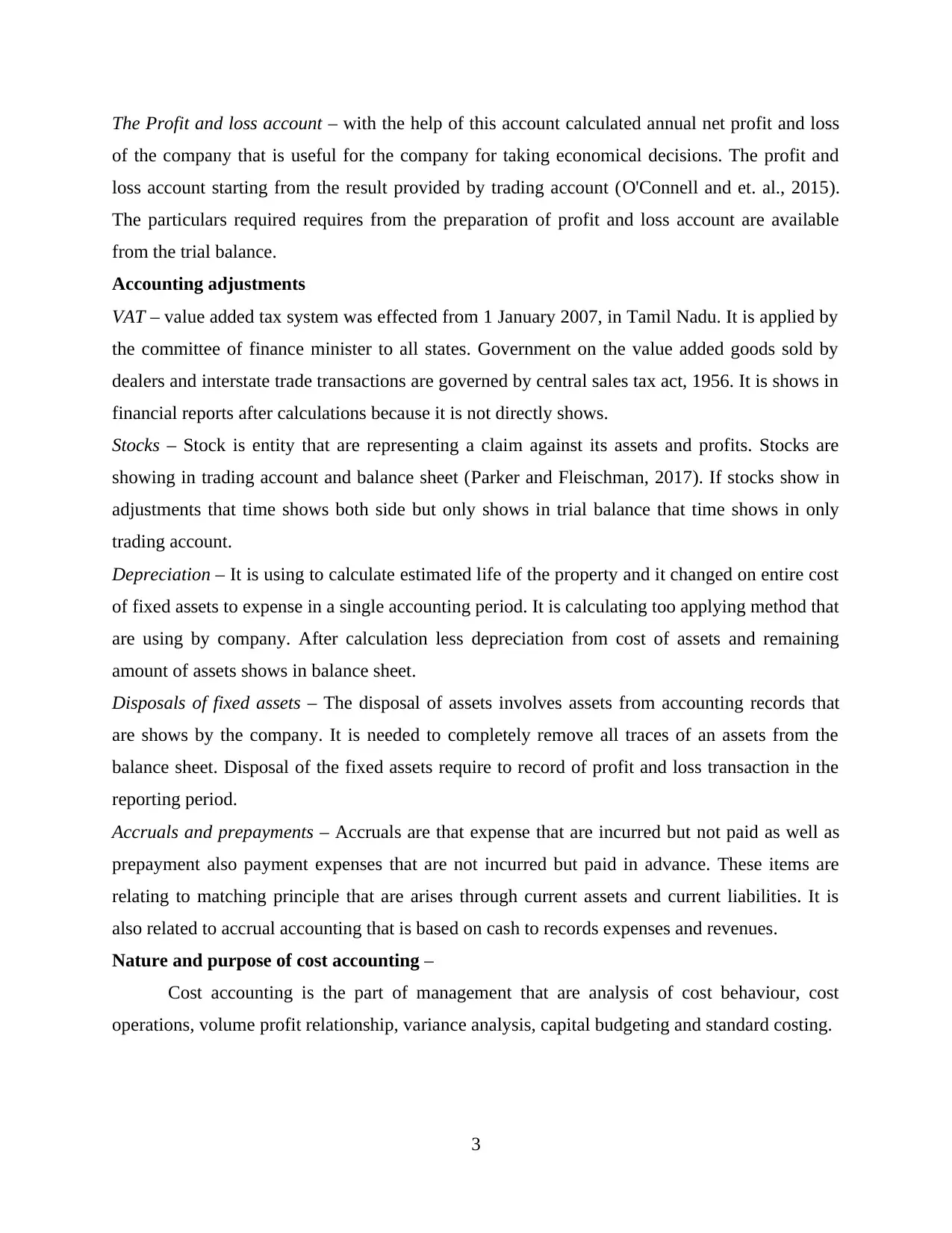
The Profit and loss account – with the help of this account calculated annual net profit and loss
of the company that is useful for the company for taking economical decisions. The profit and
loss account starting from the result provided by trading account (O'Connell and et. al., 2015).
The particulars required requires from the preparation of profit and loss account are available
from the trial balance.
Accounting adjustments
VAT – value added tax system was effected from 1 January 2007, in Tamil Nadu. It is applied by
the committee of finance minister to all states. Government on the value added goods sold by
dealers and interstate trade transactions are governed by central sales tax act, 1956. It is shows in
financial reports after calculations because it is not directly shows.
Stocks – Stock is entity that are representing a claim against its assets and profits. Stocks are
showing in trading account and balance sheet (Parker and Fleischman, 2017). If stocks show in
adjustments that time shows both side but only shows in trial balance that time shows in only
trading account.
Depreciation – It is using to calculate estimated life of the property and it changed on entire cost
of fixed assets to expense in a single accounting period. It is calculating too applying method that
are using by company. After calculation less depreciation from cost of assets and remaining
amount of assets shows in balance sheet.
Disposals of fixed assets – The disposal of assets involves assets from accounting records that
are shows by the company. It is needed to completely remove all traces of an assets from the
balance sheet. Disposal of the fixed assets require to record of profit and loss transaction in the
reporting period.
Accruals and prepayments – Accruals are that expense that are incurred but not paid as well as
prepayment also payment expenses that are not incurred but paid in advance. These items are
relating to matching principle that are arises through current assets and current liabilities. It is
also related to accrual accounting that is based on cash to records expenses and revenues.
Nature and purpose of cost accounting –
Cost accounting is the part of management that are analysis of cost behaviour, cost
operations, volume profit relationship, variance analysis, capital budgeting and standard costing.
3
of the company that is useful for the company for taking economical decisions. The profit and
loss account starting from the result provided by trading account (O'Connell and et. al., 2015).
The particulars required requires from the preparation of profit and loss account are available
from the trial balance.
Accounting adjustments
VAT – value added tax system was effected from 1 January 2007, in Tamil Nadu. It is applied by
the committee of finance minister to all states. Government on the value added goods sold by
dealers and interstate trade transactions are governed by central sales tax act, 1956. It is shows in
financial reports after calculations because it is not directly shows.
Stocks – Stock is entity that are representing a claim against its assets and profits. Stocks are
showing in trading account and balance sheet (Parker and Fleischman, 2017). If stocks show in
adjustments that time shows both side but only shows in trial balance that time shows in only
trading account.
Depreciation – It is using to calculate estimated life of the property and it changed on entire cost
of fixed assets to expense in a single accounting period. It is calculating too applying method that
are using by company. After calculation less depreciation from cost of assets and remaining
amount of assets shows in balance sheet.
Disposals of fixed assets – The disposal of assets involves assets from accounting records that
are shows by the company. It is needed to completely remove all traces of an assets from the
balance sheet. Disposal of the fixed assets require to record of profit and loss transaction in the
reporting period.
Accruals and prepayments – Accruals are that expense that are incurred but not paid as well as
prepayment also payment expenses that are not incurred but paid in advance. These items are
relating to matching principle that are arises through current assets and current liabilities. It is
also related to accrual accounting that is based on cash to records expenses and revenues.
Nature and purpose of cost accounting –
Cost accounting is the part of management that are analysis of cost behaviour, cost
operations, volume profit relationship, variance analysis, capital budgeting and standard costing.
3
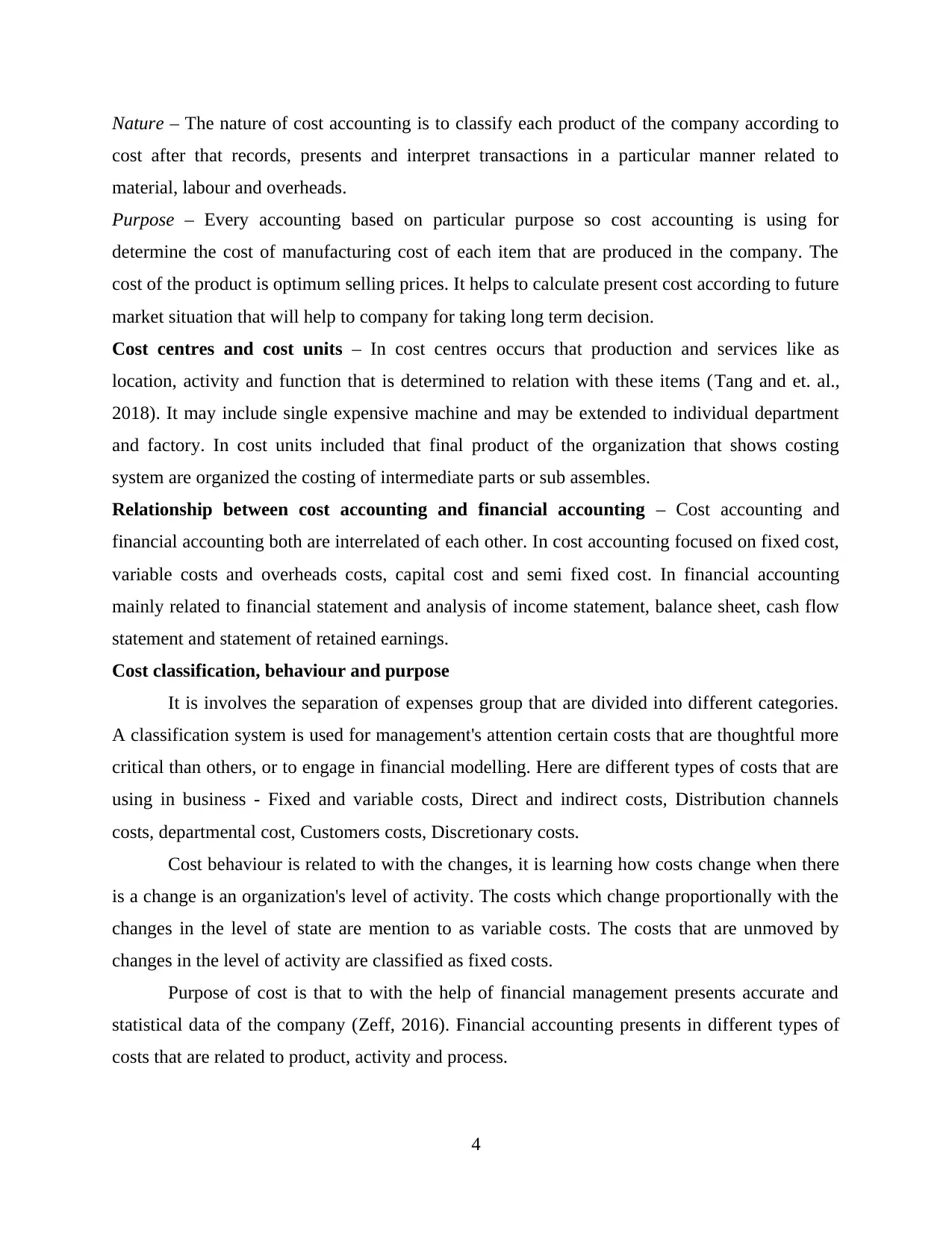
Nature – The nature of cost accounting is to classify each product of the company according to
cost after that records, presents and interpret transactions in a particular manner related to
material, labour and overheads.
Purpose – Every accounting based on particular purpose so cost accounting is using for
determine the cost of manufacturing cost of each item that are produced in the company. The
cost of the product is optimum selling prices. It helps to calculate present cost according to future
market situation that will help to company for taking long term decision.
Cost centres and cost units – In cost centres occurs that production and services like as
location, activity and function that is determined to relation with these items (Tang and et. al.,
2018). It may include single expensive machine and may be extended to individual department
and factory. In cost units included that final product of the organization that shows costing
system are organized the costing of intermediate parts or sub assembles.
Relationship between cost accounting and financial accounting – Cost accounting and
financial accounting both are interrelated of each other. In cost accounting focused on fixed cost,
variable costs and overheads costs, capital cost and semi fixed cost. In financial accounting
mainly related to financial statement and analysis of income statement, balance sheet, cash flow
statement and statement of retained earnings.
Cost classification, behaviour and purpose
It is involves the separation of expenses group that are divided into different categories.
A classification system is used for management's attention certain costs that are thoughtful more
critical than others, or to engage in financial modelling. Here are different types of costs that are
using in business - Fixed and variable costs, Direct and indirect costs, Distribution channels
costs, departmental cost, Customers costs, Discretionary costs.
Cost behaviour is related to with the changes, it is learning how costs change when there
is a change is an organization's level of activity. The costs which change proportionally with the
changes in the level of state are mention to as variable costs. The costs that are unmoved by
changes in the level of activity are classified as fixed costs.
Purpose of cost is that to with the help of financial management presents accurate and
statistical data of the company (Zeff, 2016). Financial accounting presents in different types of
costs that are related to product, activity and process.
4
cost after that records, presents and interpret transactions in a particular manner related to
material, labour and overheads.
Purpose – Every accounting based on particular purpose so cost accounting is using for
determine the cost of manufacturing cost of each item that are produced in the company. The
cost of the product is optimum selling prices. It helps to calculate present cost according to future
market situation that will help to company for taking long term decision.
Cost centres and cost units – In cost centres occurs that production and services like as
location, activity and function that is determined to relation with these items (Tang and et. al.,
2018). It may include single expensive machine and may be extended to individual department
and factory. In cost units included that final product of the organization that shows costing
system are organized the costing of intermediate parts or sub assembles.
Relationship between cost accounting and financial accounting – Cost accounting and
financial accounting both are interrelated of each other. In cost accounting focused on fixed cost,
variable costs and overheads costs, capital cost and semi fixed cost. In financial accounting
mainly related to financial statement and analysis of income statement, balance sheet, cash flow
statement and statement of retained earnings.
Cost classification, behaviour and purpose
It is involves the separation of expenses group that are divided into different categories.
A classification system is used for management's attention certain costs that are thoughtful more
critical than others, or to engage in financial modelling. Here are different types of costs that are
using in business - Fixed and variable costs, Direct and indirect costs, Distribution channels
costs, departmental cost, Customers costs, Discretionary costs.
Cost behaviour is related to with the changes, it is learning how costs change when there
is a change is an organization's level of activity. The costs which change proportionally with the
changes in the level of state are mention to as variable costs. The costs that are unmoved by
changes in the level of activity are classified as fixed costs.
Purpose of cost is that to with the help of financial management presents accurate and
statistical data of the company (Zeff, 2016). Financial accounting presents in different types of
costs that are related to product, activity and process.
4
⊘ This is a preview!⊘
Do you want full access?
Subscribe today to unlock all pages.

Trusted by 1+ million students worldwide
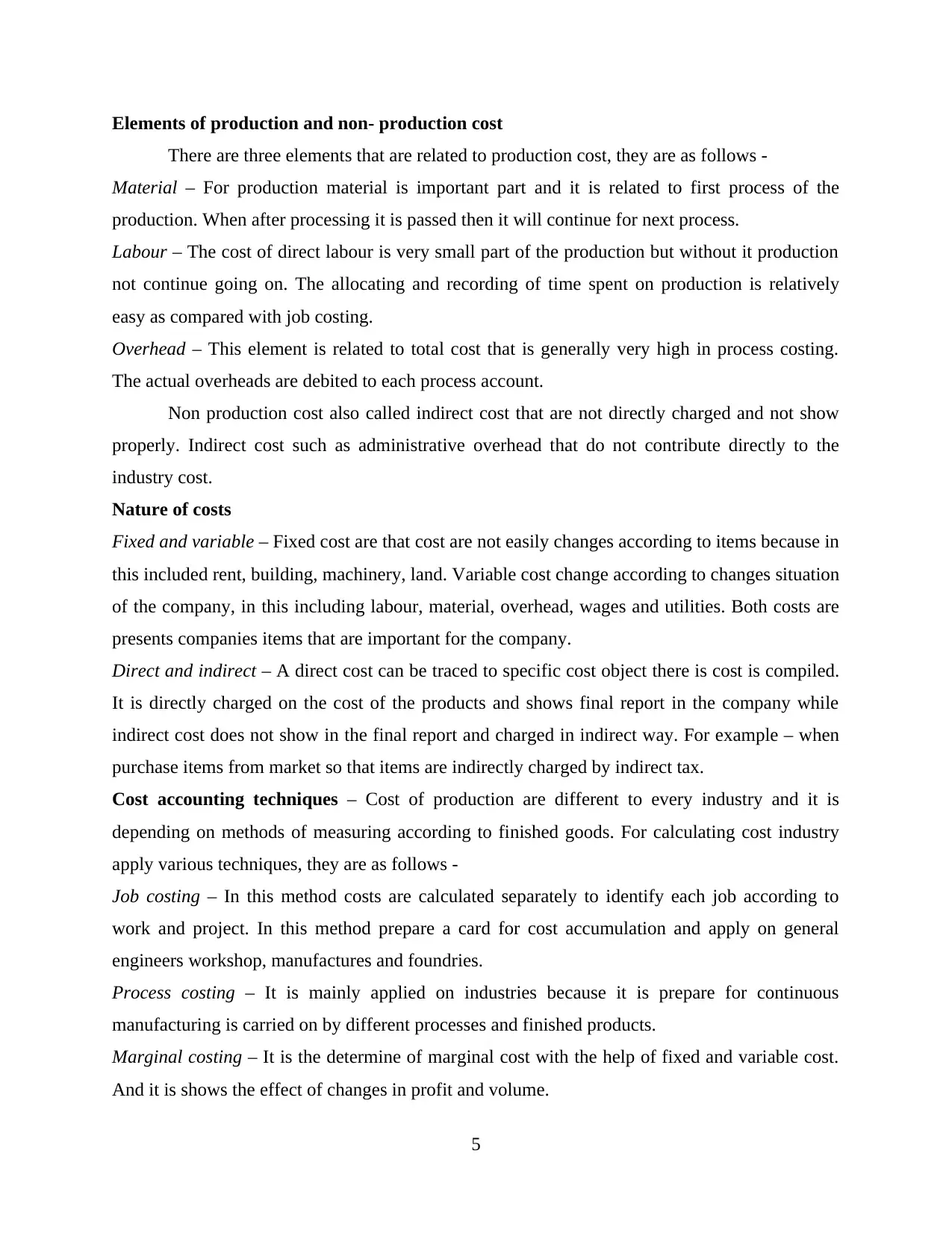
Elements of production and non- production cost
There are three elements that are related to production cost, they are as follows -
Material – For production material is important part and it is related to first process of the
production. When after processing it is passed then it will continue for next process.
Labour – The cost of direct labour is very small part of the production but without it production
not continue going on. The allocating and recording of time spent on production is relatively
easy as compared with job costing.
Overhead – This element is related to total cost that is generally very high in process costing.
The actual overheads are debited to each process account.
Non production cost also called indirect cost that are not directly charged and not show
properly. Indirect cost such as administrative overhead that do not contribute directly to the
industry cost.
Nature of costs
Fixed and variable – Fixed cost are that cost are not easily changes according to items because in
this included rent, building, machinery, land. Variable cost change according to changes situation
of the company, in this including labour, material, overhead, wages and utilities. Both costs are
presents companies items that are important for the company.
Direct and indirect – A direct cost can be traced to specific cost object there is cost is compiled.
It is directly charged on the cost of the products and shows final report in the company while
indirect cost does not show in the final report and charged in indirect way. For example – when
purchase items from market so that items are indirectly charged by indirect tax.
Cost accounting techniques – Cost of production are different to every industry and it is
depending on methods of measuring according to finished goods. For calculating cost industry
apply various techniques, they are as follows -
Job costing – In this method costs are calculated separately to identify each job according to
work and project. In this method prepare a card for cost accumulation and apply on general
engineers workshop, manufactures and foundries.
Process costing – It is mainly applied on industries because it is prepare for continuous
manufacturing is carried on by different processes and finished products.
Marginal costing – It is the determine of marginal cost with the help of fixed and variable cost.
And it is shows the effect of changes in profit and volume.
5
There are three elements that are related to production cost, they are as follows -
Material – For production material is important part and it is related to first process of the
production. When after processing it is passed then it will continue for next process.
Labour – The cost of direct labour is very small part of the production but without it production
not continue going on. The allocating and recording of time spent on production is relatively
easy as compared with job costing.
Overhead – This element is related to total cost that is generally very high in process costing.
The actual overheads are debited to each process account.
Non production cost also called indirect cost that are not directly charged and not show
properly. Indirect cost such as administrative overhead that do not contribute directly to the
industry cost.
Nature of costs
Fixed and variable – Fixed cost are that cost are not easily changes according to items because in
this included rent, building, machinery, land. Variable cost change according to changes situation
of the company, in this including labour, material, overhead, wages and utilities. Both costs are
presents companies items that are important for the company.
Direct and indirect – A direct cost can be traced to specific cost object there is cost is compiled.
It is directly charged on the cost of the products and shows final report in the company while
indirect cost does not show in the final report and charged in indirect way. For example – when
purchase items from market so that items are indirectly charged by indirect tax.
Cost accounting techniques – Cost of production are different to every industry and it is
depending on methods of measuring according to finished goods. For calculating cost industry
apply various techniques, they are as follows -
Job costing – In this method costs are calculated separately to identify each job according to
work and project. In this method prepare a card for cost accumulation and apply on general
engineers workshop, manufactures and foundries.
Process costing – It is mainly applied on industries because it is prepare for continuous
manufacturing is carried on by different processes and finished products.
Marginal costing – It is the determine of marginal cost with the help of fixed and variable cost.
And it is shows the effect of changes in profit and volume.
5
Paraphrase This Document
Need a fresh take? Get an instant paraphrase of this document with our AI Paraphraser
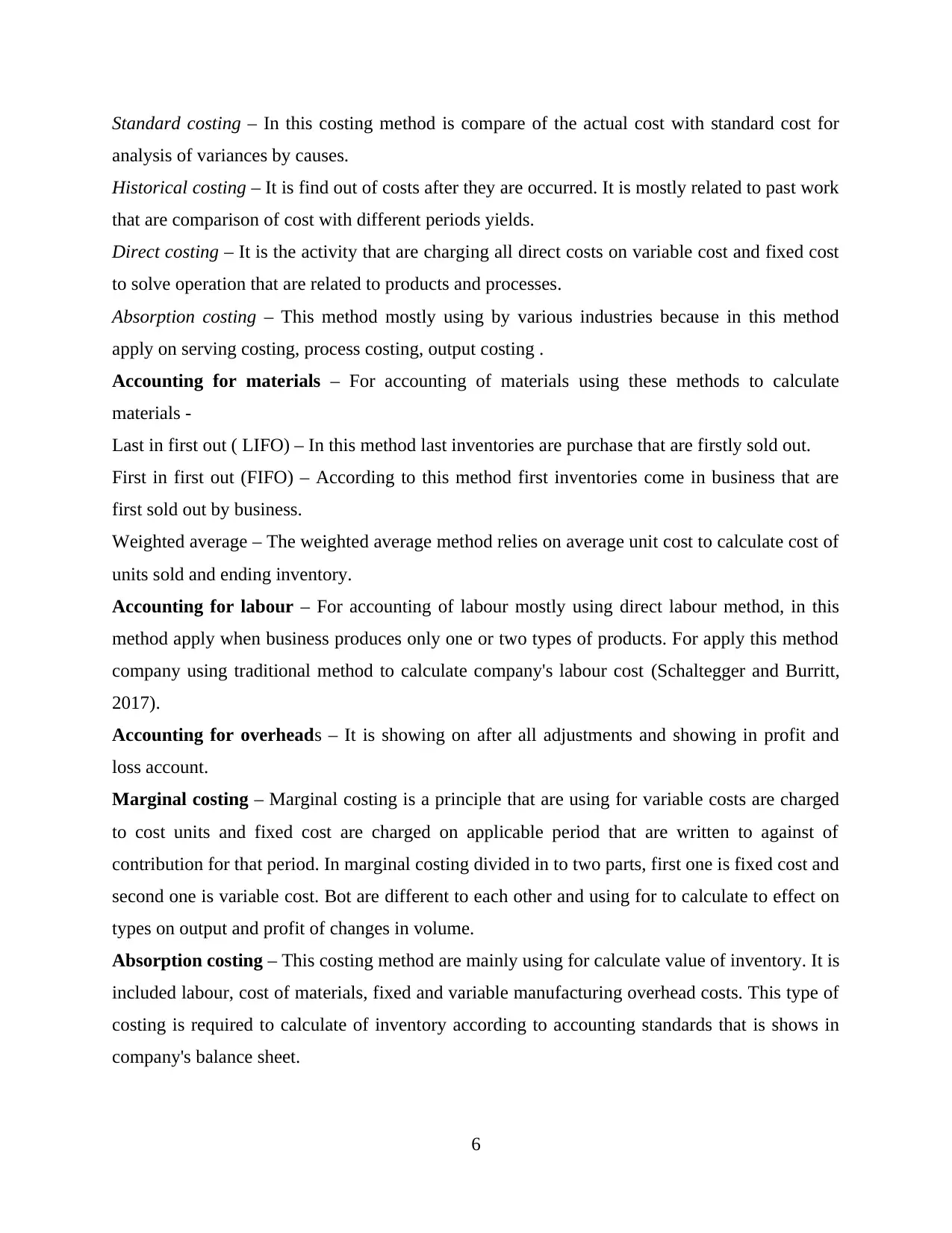
Standard costing – In this costing method is compare of the actual cost with standard cost for
analysis of variances by causes.
Historical costing – It is find out of costs after they are occurred. It is mostly related to past work
that are comparison of cost with different periods yields.
Direct costing – It is the activity that are charging all direct costs on variable cost and fixed cost
to solve operation that are related to products and processes.
Absorption costing – This method mostly using by various industries because in this method
apply on serving costing, process costing, output costing .
Accounting for materials – For accounting of materials using these methods to calculate
materials -
Last in first out ( LIFO) – In this method last inventories are purchase that are firstly sold out.
First in first out (FIFO) – According to this method first inventories come in business that are
first sold out by business.
Weighted average – The weighted average method relies on average unit cost to calculate cost of
units sold and ending inventory.
Accounting for labour – For accounting of labour mostly using direct labour method, in this
method apply when business produces only one or two types of products. For apply this method
company using traditional method to calculate company's labour cost (Schaltegger and Burritt,
2017).
Accounting for overheads – It is showing on after all adjustments and showing in profit and
loss account.
Marginal costing – Marginal costing is a principle that are using for variable costs are charged
to cost units and fixed cost are charged on applicable period that are written to against of
contribution for that period. In marginal costing divided in to two parts, first one is fixed cost and
second one is variable cost. Bot are different to each other and using for to calculate to effect on
types on output and profit of changes in volume.
Absorption costing – This costing method are mainly using for calculate value of inventory. It is
included labour, cost of materials, fixed and variable manufacturing overhead costs. This type of
costing is required to calculate of inventory according to accounting standards that is shows in
company's balance sheet.
6
analysis of variances by causes.
Historical costing – It is find out of costs after they are occurred. It is mostly related to past work
that are comparison of cost with different periods yields.
Direct costing – It is the activity that are charging all direct costs on variable cost and fixed cost
to solve operation that are related to products and processes.
Absorption costing – This method mostly using by various industries because in this method
apply on serving costing, process costing, output costing .
Accounting for materials – For accounting of materials using these methods to calculate
materials -
Last in first out ( LIFO) – In this method last inventories are purchase that are firstly sold out.
First in first out (FIFO) – According to this method first inventories come in business that are
first sold out by business.
Weighted average – The weighted average method relies on average unit cost to calculate cost of
units sold and ending inventory.
Accounting for labour – For accounting of labour mostly using direct labour method, in this
method apply when business produces only one or two types of products. For apply this method
company using traditional method to calculate company's labour cost (Schaltegger and Burritt,
2017).
Accounting for overheads – It is showing on after all adjustments and showing in profit and
loss account.
Marginal costing – Marginal costing is a principle that are using for variable costs are charged
to cost units and fixed cost are charged on applicable period that are written to against of
contribution for that period. In marginal costing divided in to two parts, first one is fixed cost and
second one is variable cost. Bot are different to each other and using for to calculate to effect on
types on output and profit of changes in volume.
Absorption costing – This costing method are mainly using for calculate value of inventory. It is
included labour, cost of materials, fixed and variable manufacturing overhead costs. This type of
costing is required to calculate of inventory according to accounting standards that is shows in
company's balance sheet.
6
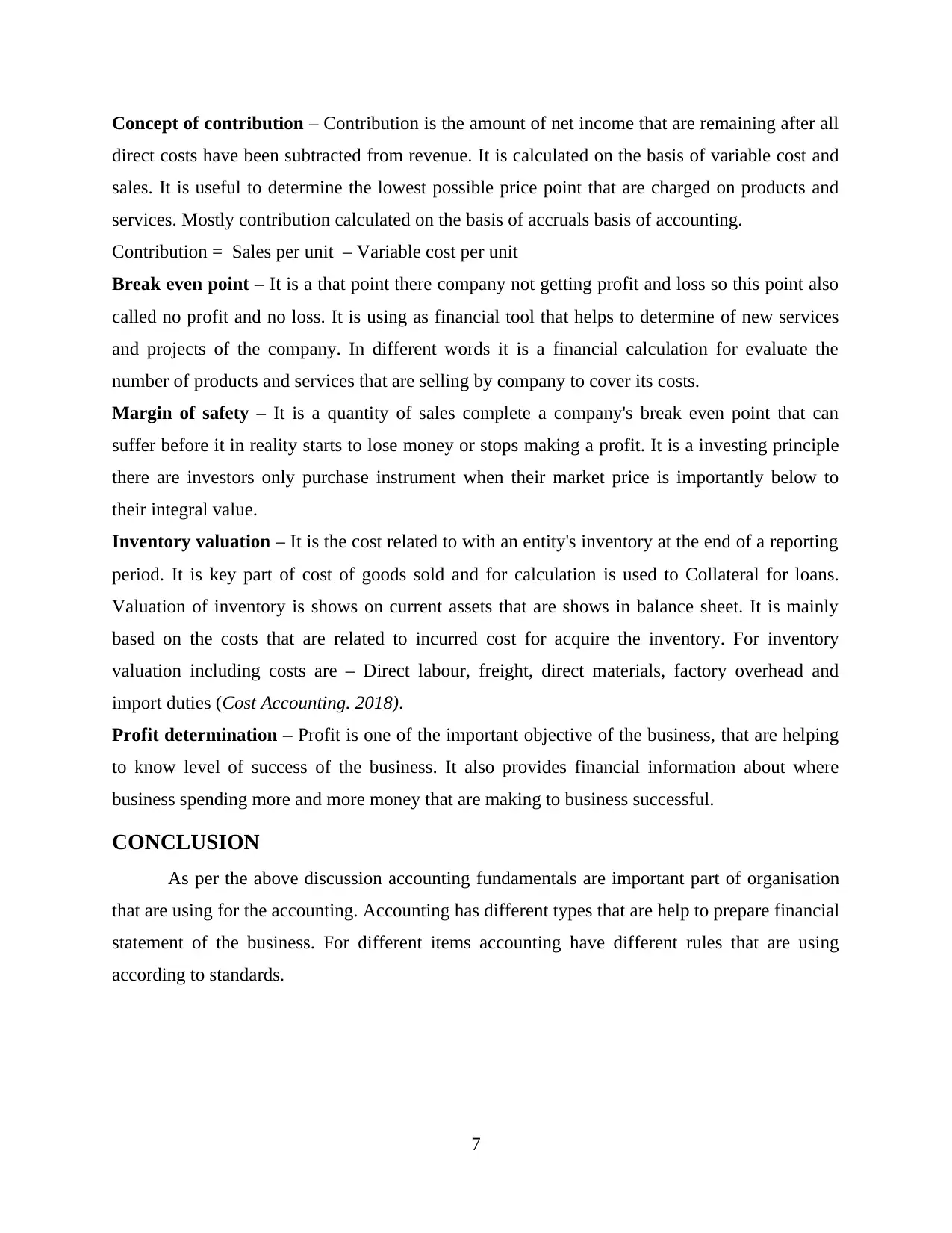
Concept of contribution – Contribution is the amount of net income that are remaining after all
direct costs have been subtracted from revenue. It is calculated on the basis of variable cost and
sales. It is useful to determine the lowest possible price point that are charged on products and
services. Mostly contribution calculated on the basis of accruals basis of accounting.
Contribution = Sales per unit – Variable cost per unit
Break even point – It is a that point there company not getting profit and loss so this point also
called no profit and no loss. It is using as financial tool that helps to determine of new services
and projects of the company. In different words it is a financial calculation for evaluate the
number of products and services that are selling by company to cover its costs.
Margin of safety – It is a quantity of sales complete a company's break even point that can
suffer before it in reality starts to lose money or stops making a profit. It is a investing principle
there are investors only purchase instrument when their market price is importantly below to
their integral value.
Inventory valuation – It is the cost related to with an entity's inventory at the end of a reporting
period. It is key part of cost of goods sold and for calculation is used to Collateral for loans.
Valuation of inventory is shows on current assets that are shows in balance sheet. It is mainly
based on the costs that are related to incurred cost for acquire the inventory. For inventory
valuation including costs are – Direct labour, freight, direct materials, factory overhead and
import duties (Cost Accounting. 2018).
Profit determination – Profit is one of the important objective of the business, that are helping
to know level of success of the business. It also provides financial information about where
business spending more and more money that are making to business successful.
CONCLUSION
As per the above discussion accounting fundamentals are important part of organisation
that are using for the accounting. Accounting has different types that are help to prepare financial
statement of the business. For different items accounting have different rules that are using
according to standards.
7
direct costs have been subtracted from revenue. It is calculated on the basis of variable cost and
sales. It is useful to determine the lowest possible price point that are charged on products and
services. Mostly contribution calculated on the basis of accruals basis of accounting.
Contribution = Sales per unit – Variable cost per unit
Break even point – It is a that point there company not getting profit and loss so this point also
called no profit and no loss. It is using as financial tool that helps to determine of new services
and projects of the company. In different words it is a financial calculation for evaluate the
number of products and services that are selling by company to cover its costs.
Margin of safety – It is a quantity of sales complete a company's break even point that can
suffer before it in reality starts to lose money or stops making a profit. It is a investing principle
there are investors only purchase instrument when their market price is importantly below to
their integral value.
Inventory valuation – It is the cost related to with an entity's inventory at the end of a reporting
period. It is key part of cost of goods sold and for calculation is used to Collateral for loans.
Valuation of inventory is shows on current assets that are shows in balance sheet. It is mainly
based on the costs that are related to incurred cost for acquire the inventory. For inventory
valuation including costs are – Direct labour, freight, direct materials, factory overhead and
import duties (Cost Accounting. 2018).
Profit determination – Profit is one of the important objective of the business, that are helping
to know level of success of the business. It also provides financial information about where
business spending more and more money that are making to business successful.
CONCLUSION
As per the above discussion accounting fundamentals are important part of organisation
that are using for the accounting. Accounting has different types that are help to prepare financial
statement of the business. For different items accounting have different rules that are using
according to standards.
7
⊘ This is a preview!⊘
Do you want full access?
Subscribe today to unlock all pages.

Trusted by 1+ million students worldwide
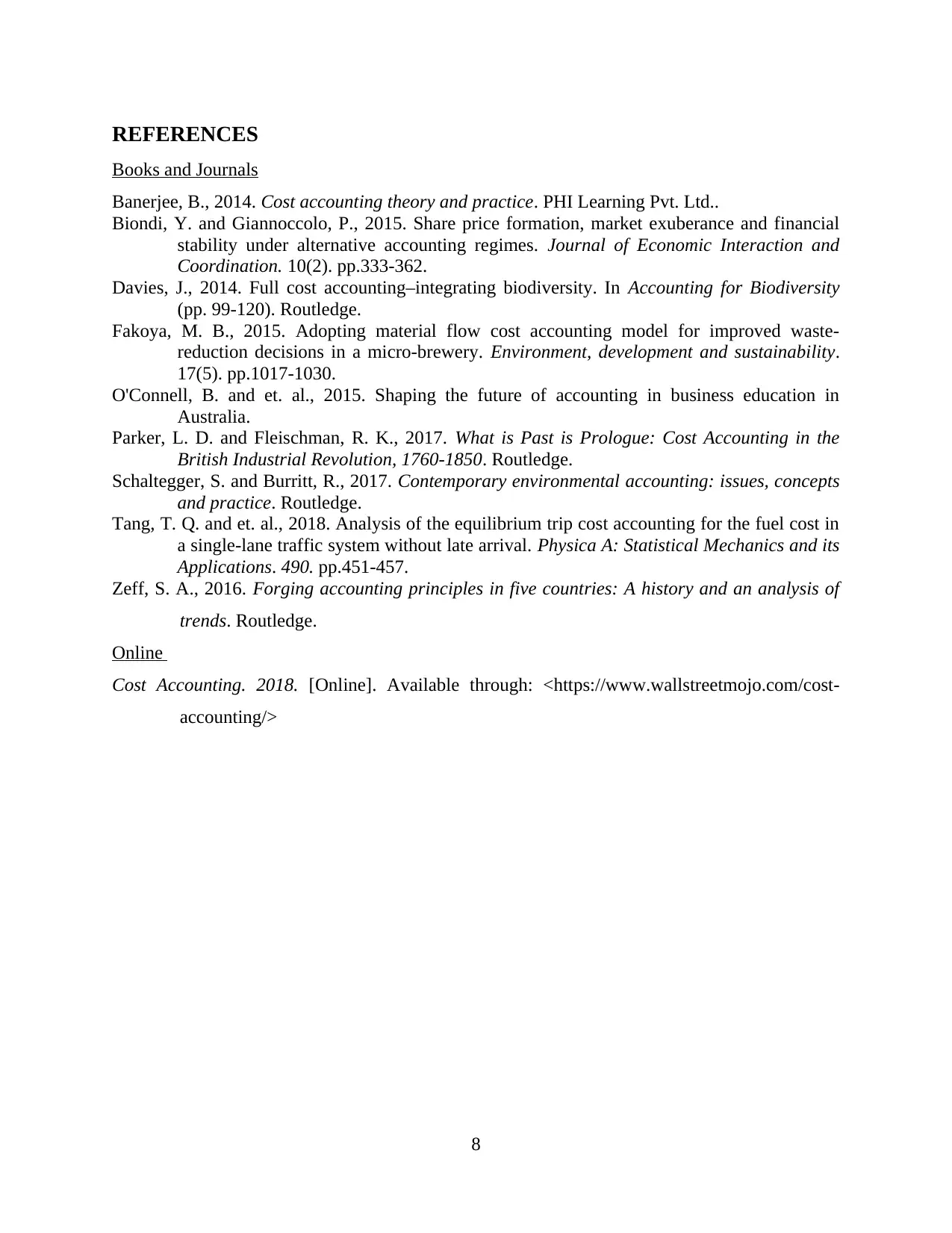
REFERENCES
Books and Journals
Banerjee, B., 2014. Cost accounting theory and practice. PHI Learning Pvt. Ltd..
Biondi, Y. and Giannoccolo, P., 2015. Share price formation, market exuberance and financial
stability under alternative accounting regimes. Journal of Economic Interaction and
Coordination. 10(2). pp.333-362.
Davies, J., 2014. Full cost accounting–integrating biodiversity. In Accounting for Biodiversity
(pp. 99-120). Routledge.
Fakoya, M. B., 2015. Adopting material flow cost accounting model for improved waste-
reduction decisions in a micro-brewery. Environment, development and sustainability.
17(5). pp.1017-1030.
O'Connell, B. and et. al., 2015. Shaping the future of accounting in business education in
Australia.
Parker, L. D. and Fleischman, R. K., 2017. What is Past is Prologue: Cost Accounting in the
British Industrial Revolution, 1760-1850. Routledge.
Schaltegger, S. and Burritt, R., 2017. Contemporary environmental accounting: issues, concepts
and practice. Routledge.
Tang, T. Q. and et. al., 2018. Analysis of the equilibrium trip cost accounting for the fuel cost in
a single-lane traffic system without late arrival. Physica A: Statistical Mechanics and its
Applications. 490. pp.451-457.
Zeff, S. A., 2016. Forging accounting principles in five countries: A history and an analysis of
trends. Routledge.
Online
Cost Accounting. 2018. [Online]. Available through: <https://www.wallstreetmojo.com/cost-
accounting/>
8
Books and Journals
Banerjee, B., 2014. Cost accounting theory and practice. PHI Learning Pvt. Ltd..
Biondi, Y. and Giannoccolo, P., 2015. Share price formation, market exuberance and financial
stability under alternative accounting regimes. Journal of Economic Interaction and
Coordination. 10(2). pp.333-362.
Davies, J., 2014. Full cost accounting–integrating biodiversity. In Accounting for Biodiversity
(pp. 99-120). Routledge.
Fakoya, M. B., 2015. Adopting material flow cost accounting model for improved waste-
reduction decisions in a micro-brewery. Environment, development and sustainability.
17(5). pp.1017-1030.
O'Connell, B. and et. al., 2015. Shaping the future of accounting in business education in
Australia.
Parker, L. D. and Fleischman, R. K., 2017. What is Past is Prologue: Cost Accounting in the
British Industrial Revolution, 1760-1850. Routledge.
Schaltegger, S. and Burritt, R., 2017. Contemporary environmental accounting: issues, concepts
and practice. Routledge.
Tang, T. Q. and et. al., 2018. Analysis of the equilibrium trip cost accounting for the fuel cost in
a single-lane traffic system without late arrival. Physica A: Statistical Mechanics and its
Applications. 490. pp.451-457.
Zeff, S. A., 2016. Forging accounting principles in five countries: A history and an analysis of
trends. Routledge.
Online
Cost Accounting. 2018. [Online]. Available through: <https://www.wallstreetmojo.com/cost-
accounting/>
8
1 out of 10
Related Documents
Your All-in-One AI-Powered Toolkit for Academic Success.
+13062052269
info@desklib.com
Available 24*7 on WhatsApp / Email
![[object Object]](/_next/static/media/star-bottom.7253800d.svg)
Unlock your academic potential
Copyright © 2020–2025 A2Z Services. All Rights Reserved. Developed and managed by ZUCOL.





